That’ll depend largely on your finances and how you plan to use the HELOC. Relatively high home values mean that you may have access to more cash now than you will in the future. The squeeze of inflation is also very real right now, and a HELOC could help ease some of that strain. However, there’s never a good time to take out a HELOC whose payments you can’t afford. The negative consequences of late payments or default can be severe, both for your credit score and your ability to stay in your home.
Market considerations
In general, it’s a good time to get a HELOC if the prime rate isn’t going to rise sharply over the loan’s term. That’s because the prime rate, a benchmark rate used to calculate many variable interest rates, largely determines HELOC rates. If it goes up, your loan becomes more expensive. If it goes down, you can potentially get away with paying less than borrowers with comparable fixed-rate loans.
Of course, no one can predict the future but the prime rate has been climbing for several years. At the end of 2024 it sat 3.5 percentage points higher than where it had been in early 2020.
How to decide if a HELOC is a good idea for you
Ultimately, it’s impossible to predict with certainty where the market will go. If you’re considering a HELOC, make sure that you can afford the payments at both the loan’s lowest and highest possible rates. (All HELOCs come with a “ceiling,” which sets a limit on how high your rate can rise at any time during the loan term.)













